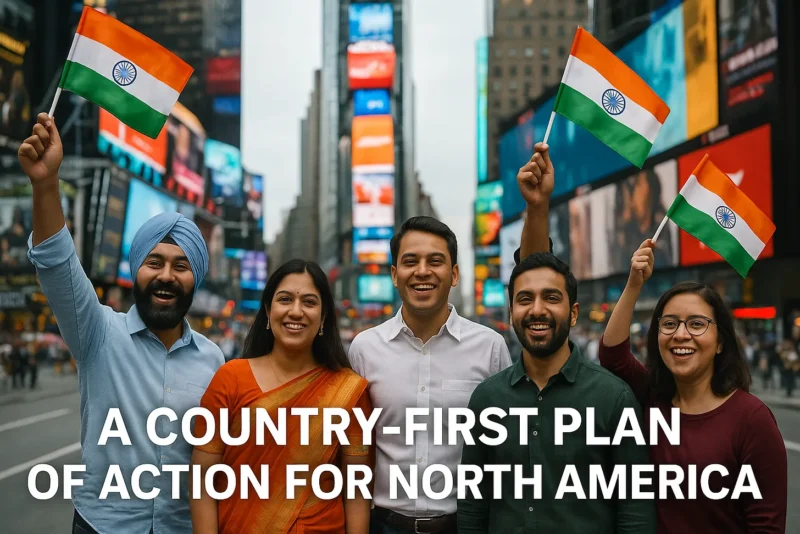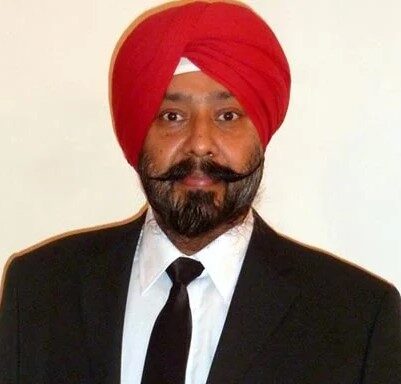 This brief paper is offered as a civil-society contribution to India’s foreign-policy process at a time when the India–North America relationship is passing through a lean patch. The reputational spill-over is being felt by Indian-origin communities in the United States and Canada, where a small number of noisy, performative displays risk colouring perceptions of a diverse and law-abiding majority. Our aim is neither to apportion blame nor to rehearse culture-war tropes, but to propose a practical reset that is constitutional, plural and resolutely non-partisan.
This brief paper is offered as a civil-society contribution to India’s foreign-policy process at a time when the India–North America relationship is passing through a lean patch. The reputational spill-over is being felt by Indian-origin communities in the United States and Canada, where a small number of noisy, performative displays risk colouring perceptions of a diverse and law-abiding majority. Our aim is neither to apportion blame nor to rehearse culture-war tropes, but to propose a practical reset that is constitutional, plural and resolutely non-partisan.
For context and only as a single data-point: a recent private note from a retired security practitioner argued that “mobilised” diaspora activism sometimes lapses into triumphalism and thereby invites needless scrutiny. We note the concern, without giving it undue primacy, because the real work is forward-looking: to steady India’s image by aligning our overseas civic footprint with our democratic values and long-term interests. The method is simple—service before spectacle, bridges over billboards, programmes over processions.
2) Guardrails and Tone — Country-First, Faith-Neutral, Party-Agnostic
Policy must begin with guardrails that are public, concise and actionable.
Country-first: Outreach by Indian organisations abroad should showcase India’s constitutional pluralism, scientific ambition and economic pragmatism. It must never be read as a surrogate for any political party at home.
Faith-neutral: Temples, gurdwaras, mosques, churches, Jain derasars and Buddhist centres are community anchors, not exclusive banners. The default optic should be interfaith. Rotate venues and leadership so no institution appears to be the flagship “face” of India.
Party-agnostic in host democracies: Engage both sides of the aisle in the U.S. and Canada, and work as closely with city councils, school boards and provincial/state administrations as with federal actors. Sub-national cooperation creates ballast that survives national-level headwinds.
Civic tone: Prefer calm competence to combative pageantry. Celebrate culture without provocation; keep public communications rooted in local priorities—jobs, education, small business compliance, research partnerships, public safety—rather than importing distant quarrels. Replace triumphalist slogans with evidence of service and problem-solving.
For South Block and Missions, a short “Country-First Diaspora Charter” can set expectations: no partisan branding; no exclusionary messaging; clear rules on the use of official premises; transparency requirements for organisations receiving consular micro-grants.
3) Programme Architecture — Service Diplomacy, Business Resilience, and Campus Bridges
A strategy is only as good as its programmes. We propose five immediately replicable tracks:
(a) Service Diplomacy Weeks (five hubs). In New York, Washington, Toronto, Vancouver and the Bay Area, run seven-day marathons of joint volunteering with local partners: food banks, STEM tutoring, veterans’ clinics, school refurbishments, library upgrades. Close each week with a civic reception where mayors, school superintendents, first responders and community organisers meet Indian-origin professionals and students. Visibly interfaith, visibly inter-generational, resolutely non-partisan.

(b) Compliance Clinics for SMEs (quarterly). The loudest arguments rarely decide whether a shop survives; paperwork does. Host rotating clinics in Edison (NJ), Artesia (CA), Brampton (ON) and Surrey (BC) on customs classification, product-safety labelling, labour law, tax and ESG. Pair retired regulators and trade lawyers with small businesses. Prepared firms keep trading through policy squalls without drama—an influence multiplier worth more than a parade.
(c) Future Industries Council (non-partisan). Convene senior technologists, veteran investors and second-time founders with academics to run three workstreams: (1) resilient supply chains in electronics, med-tech and clean energy; (2) open standards in AI and semiconductors; (3) youth pipelines from Tier-2/3 Indian cities to North American labs and community colleges. Publish milestones, not manifestos.
(d) City-to-City Green Corridors (consular facilitation). Federal frictions need not halt municipal progress. Broker MOUs on water reuse, EV buses, building efficiency and digital public goods between Indian cities and North American counties. City halls move faster, produce tangible benefits and de-risk the relationship at ground level.
(e) University Bridges (from confrontation to construction). Replace counter-protests with scholarships, chairs and joint research in health, climate, semiconductors, water and agriculture. Fund India Fellows for three-month lab placements both ways. A confident country invites hard questions and invests in the “middle” of campus life—faculty trust, student curiosity, administrative goodwill.
4) Inclusion by Design — Muslim and Sikh Engagement Without Tokenism
Pluralism is not a talking point; it is a design principle.
Muslim engagement: Make it routine and programmatic, not decorative. Build year-round partnerships with Indian-origin Muslim professional bodies in medicine, law, tech and small business. Co-host scholarships with secular eligibility, rotate venues for Eid open houses and Ramadan food drives, and ensure representation on every economic and civic panel. The fact—often ignored—is that India houses one of the world’s largest Muslim populations; our overseas posture should reflect that reality with dignity and regularity.
Sikh engagement: Foreground the entrepreneurial mainstream—transporters, veterans, engineers, farmers, academics and creators—across Ottawa, Surrey, Brampton, Yuba City and California’s Central Valley. Prioritise mentorship networks, veterans’ welfare tie-ups and anti-hate training with law enforcement. Calmly separate the microscopic “Khalistani” extremist fringe from the vast majority who build and serve; the best way to marginalise provocation is to amplify constructive leadership and widen the platforms where mainstream Sikh voices set the agenda.
Interfaith as habit: Normalise joint hosting—temple-led food drive this month, gurdwara-led veterans’ clinic next, mosque-hosted small-business fair thereafter, church-based literacy programme after that. When pluralism becomes muscle memory, optics take care of themselves and credibility compounds.
5) Communications, Governance and Risk — Professionalise the Front Line
Spokespeople and media: Name trained, credible spokespeople with standing beyond the community. Invest in media coaching, op-ed craft and crisis drills. Prefer long-form conversations to shout shows; prefer town halls to social-media brawls. Correct misinformation once, clearly, and move on. Dignified restraint often disarms a troll more than engagement.
Digital discipline: Adopt a two-click rule before posting; avoid demeaning language and imported hashtag wars; document service, not taunts. Equip volunteers with factual briefs on visas, education pathways and compliance basics, plus a concise “do-not-engage” protocol.
Ethics and structure: In each major metro, federate Indian organisations under a lean secretariat with an independent advisory board spanning professions and faiths. Build firewalls between civic programming and partisan politics. Publish an annual report with programme counts, funds raised and spent, and outcomes delivered. Create an ombuds office to hear grievances—especially from those who feel excluded—and empower it to recommend course corrections.
Consular role: Missions should convene and quality-assure, not stage-manage. Offer small, competitive grants for interfaith service projects, scholarships and compliance clinics, conditioned on non-partisan governance and transparent accounting. Maintain a rapid-response desk to quietly de-escalate local tensions before they spiral.
6) Implementation and Measurement — A 100-Day Sprint and a 12-Month Scorecard
The first 100 days:
Announce the Country-First Diaspora Charter and circulate a model code of conduct.
Publish the Service Diplomacy calendar for five hubs with numeric volunteer targets.
Launch compliance-clinic pilots in four neighborhoods; cap attendance only by room size.
Convene the Future Industries Council; name co-chairs and release three workstream roadmaps.
Open applications for the first cohort of India–North America Fellows; secure placements across public universities and labs.
Constitute interfaith steering groups in each hub with transparent selection, term limits and published minutes.
By 12 months, measure outcomes, not selfies:
Civic outputs: service hours delivered; interfaith events co-hosted; school, library and veterans’ projects completed; city-to-city MOUs translated into active pilots.
Economic outputs: SMEs trained; export disruptions reduced; supply-chain pilots placed; internships and apprenticeships created; research partnerships inked.
Reputation signals: local press tone analysis; renewed university partnerships; invitations from city halls and school boards; institutionalized police–community dialogues.
Governance health: number of organisations adopting the code of conduct; grievances resolved by the ombuds; annual reports published with clean accounts.
Closing note to officials, diaspora leaders and citizens
Reputation is a compound asset built from thousands of quiet acts, not a handful of loud days. Our proposal is not to mute pride but to channel it—to replace spectacle with service, provocation with partnership, and slogans with solutions. If South Block sets the tone, Missions convene the broad middle, and community organisations professionalize around programmes that the mainstream can embrace, India’s image in North America will not only stabilize; it will strengthen. When policy weather clears, the bridges we have reinforced will carry more of what truly matters: students and scholars, ideas and investments, municipal know-how and citizen friendships. That is how a confident, plural India shows up—abroad and at home—without swagger, without apology, and with results.